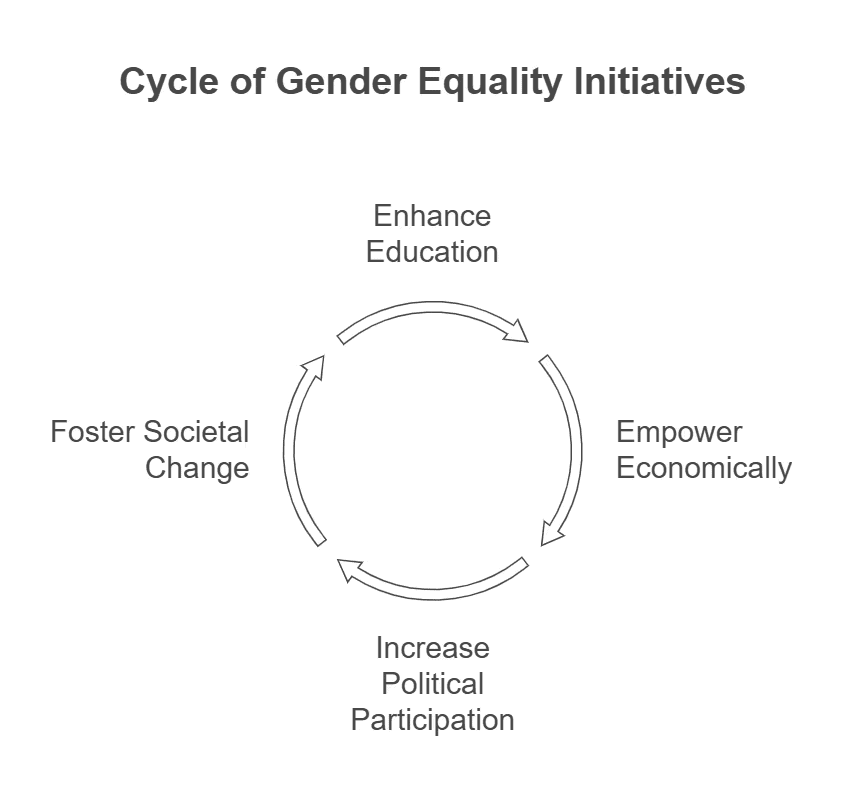The Status of Women in India is Miserable | UPSC Mains Essay Preparation PDF Download
Structure
(1) Opening
- India has a rich history and cultural background that honors women, as seen in ancient texts.
- Women are depicted as Devi and Shakti, representing love, creation, and strength.
- There is a stark difference between the traditional ideals of women’s roles and the present-day difficulties they face in India.
(2) Body
- Historical Background and Current Issues.
- Government Programs and Legal Framework.
- Social and Economic Conditions.
- The need for education, skill development, and awareness initiatives to address these challenges.
(3) Conclusion
- A call for joint and continuous efforts to improve the status of women and achieve gender equality.
- A vision of a future where women can participate equally in society, free from obstacles and discrimination.
Model Essay
India, with its deep-rooted culture that venerates women as Devi and Shakti, faces a troubling contradiction. Despite the Constitution and ancient texts portraying women as powerful figures, the current socio-economic landscape reveals a different reality. The government's initiatives to foster women’s equality reflect both advancements and the persistent hurdles in attaining gender equality.
Since gaining independence, India has enshrined gender equality in its Constitution, with Articles 14, 15, and 16 guaranteeing equal rights and opportunities for women. Historical reforms, such as the prohibition of Sati and the legalisation of widow remarriage, set the stage for contemporary women’s empowerment. Nonetheless, enduring patriarchal norms continue to hinder women’s social and economic advancement.
Although the literacy rate among women in India has risen to 70.3% (Census 2011), considerable disparities persist. Women in rural areas often lag behind their urban counterparts in literacy. Government initiatives like Beti Bachao Beti Padhao have increased awareness and enrollment, yet issues regarding the quality of education and vocational training remain, limiting women’s empowerment.
The female labour force participation (FLFP) in India has declined from 32% in 2005 to 19% in 2021, positioning it among the lowest globally. Women’s work is predominantly in the informal sector, especially in agriculture and domestic services, where their contributions are frequently overlooked. Urban women face challenges of underrepresentation in formal employment, exacerbated by wage disparities, insufficient maternity leave, and workplace harassment. Government measures, such as the Maternity Benefit Act and the Sexual Harassment of Women at Workplace Act, aim to mitigate these issues, but cultural obstacles continue to be significant.
Women in India face enduring societal norms that foster gender inequality. Issues such as child marriage, dowry, domestic violence, and restricted access to healthcare hinder their advancement. Despite the existence of laws aimed at combating these problems, enforcement and awareness are often insufficient, especially in rural regions.
To tackle these challenges, the government has introduced various initiatives:
- Education: Programs like Sukanya Samriddhi Yojana promote girls' education and financial security.
- Healthcare: The Janani Suraksha Yojana focuses on enhancing maternal and child health.
- Employment: Vocational training initiatives under the Deen Dayal Upadhyaya Grameen Kaushalya Yojana aim to improve women's employability.

Non-governmental organizations (NGOs) and media campaigns play a crucial role in addressing gender issues and advocating for women's rights.
Attaining gender equality in India necessitates targeted efforts in several important areas:
- Education: Ensuring universal access for girls, with a focus on STEM fields and vocational training, is essential for enhancing career prospects.
- Economic Empowerment: Implementing policies that guarantee equal pay, safe working environments, and flexibility for balancing work and family responsibilities is crucial.
- Political Participation: Building on the success of 33% reservations for women in local governance is vital for incorporating women's perspectives in policy-making processes.
- Societal Change: Grassroots movements, awareness campaigns, and gender-sensitive education are necessary to challenge patriarchal norms and promote a culture of respect and equality for women.
Despite significant progress in improving women's status, the road to gender parity in India remains long. Women are crucial for both social and economic development, and empowering them is not only a moral obligation but also essential for the country's growth. Creating a future where women can thrive without barriers requires a collective effort from the government, civil society, and individuals.
|
4 videos|178 docs
|
FAQs on The Status of Women in India is Miserable - UPSC Mains Essay Preparation
| 1. What are the key factors contributing to the miserable status of women in India? |  |
| 2. How does poverty impact the status of women in India? |  |
| 3. What role does education play in improving the status of women in India? |  |
| 4. What are the effects of violence against women on their status in India? |  |
| 5. What measures can be taken to improve the status of women in India? |  |






















